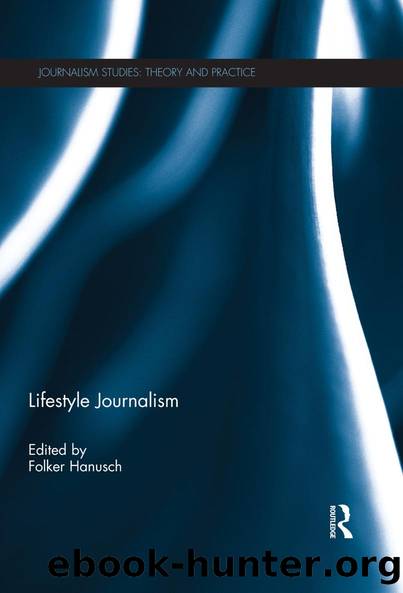Lifestyle Journalism by Folker Hanusch

Author:Folker Hanusch [Hanusch, Folker]
Language: eng
Format: epub
ISBN: 9780415827522
Barnesnoble:
Goodreads: 17242785
Publisher: Routledge
Published: 2013-05-07T00:00:00+00:00
Results and Discussion
A simple statistical analysis showed that many of the articles reflect three main attitudes (Figure 1): a culture of self-improvement (39.3 per cent frequency), a cosmopolitan attitude (31.1 per cent) and ethnic-cultural element (31.1 per cent).
FIGURE 1
Frequency of attitudes that denote nation-building expressed in food-related articles (%)
The findings also show that articles categorised as âWhere and What to Eatâ most often reflected a cosmopolitan attitude (38.3 per cent) and an ethnic-cultural element (30 per cent frequency). Articles categorised as âExperts and Expatsâ often reflected self-improvement (45.2 per cent), cosmopolitan attitudes (32.3 per cent) and an ethnic-cultural element (32.3 per cent) as it is commonplace for an expatriate or visiting expert to be asked to demonstrate his or her Singaporean credibility by commenting on the local food. Articles categorised as âPoverty and Politicsâ tended to reflect a culture of self-improvement (41.2 per cent) and concern with national interest (23.5 per cent). Only one of the articles categorised as âPoverty and Politicsâ reflected the governmentâs meritocracy policy, which suggests that government-encouraged meritocracy was delinked from poverty. Articles categorised as âHealthâ mostly reflected a culture of self-improvement and a strong achievement motivation (Figure 2).
Articles featuring local cuisines (29.9 per cent frequency) often reflected an ethnic-cultural element (64.4 per cent), while those featuring foreign cuisines (34.8 per cent) mainly reflected cosmopolitan attitudes (61.2 per cent). In terms of price, mid-range food was most common (21.7 per cent frequency) followed by low-priced (16.4 per cent) and high-priced (12.7 per cent) food (Figure 3).
One common trope was that locals are preoccupied with food. Some equated âSingaporean-nessâ with âbeing food-crazyâ, such as this article in which a 12-year-old violinist studying in Britain said:
Download
This site does not store any files on its server. We only index and link to content provided by other sites. Please contact the content providers to delete copyright contents if any and email us, we'll remove relevant links or contents immediately.
Full Circle by Michael Palin(3389)
Cuba by Lonely Planet(2579)
Birds of New Guinea by Pratt Thane K.; Beehler Bruce M.; Anderton John C(2226)
Lonely Planet Australia by Lonely Planet(2034)
Discover Australia by Lonely Planet(1905)
Beyond the Coral Sea by Michael Moran(1871)
Lonely Planet Maldives (Travel Guide) by Planet Lonely & Masters Tom(1800)
Kings Cross by Louis Nowra(1751)
Borneo Travel Guide by Lonely Planet(1681)
Ten Degrees of Reckoning: The True Story of a Family's Love and the Will to Survive by Hester Rumberg(1601)
Lonely Planet Australia (Travel Guide) by Lonely Planet & Lonely Planet(1551)
Lonely Planet South Australia & Northern Territory by Lonely Planet(1466)
Lonely Planet Pocket Hobart by Lonely Planet(1382)
The Sex Lives of Cannibals: Adrift in the Equatorial Pacific by J. Maarten Troost(1350)
Kiwi Tracks by Lonely Planet(1297)
Lonely Planet Australia (Travel Guide) by Lonely Planet(1284)
East Coast Australia by Lonely Planet(1263)
Epic Hikes of the World by Lonely Planet(1254)
Personal 03 - Personal Secrets by K.C. Wells(1238)
